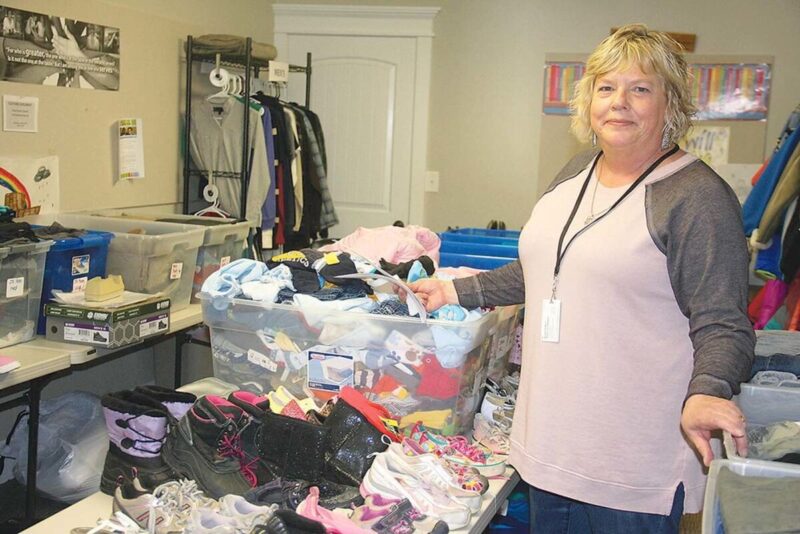Sean C. Morgan
The Sweet Home School District is looking for new ways to help its large group of homeless students.
The number of students designated as homeless in the district has been running in a range of 230 to 275 for several years.
This year, the district has counted 201 students identified as homeless, said Kristi Walker, the district’s homeless liaison. Last year, it tallied 275.
“That is still a preliminary number,” Walker said. “I hope it is better than last year, but I know that number is more than likely to go up. There is a tendency for the number to increase as weather improves. We still have five months before school is out.”
Based on last year’s figures, for districts with an enrollment over 1,500 students, Sweet Home ranked second in the state at around 10 percent of its population being students identified as homeless behind Lincoln County School District, which tallied around 11 percent, said Supt. Tom Yahraes. The state of Oregon ranks first in the nation for its percentage of youth identified as homeless.
Most of the homeless are
elementary school students, Walker said. Most of the homeless students are counted because they live in the homes of friends of families. Some high school students couch surf with their friends.
Others are living in tents, in cars and in shelters, the Jackson Street Youth Services in Albany or the HOPE Center in Sweet Home. The HOPE Center does not allow boys older than 10.
Walker said the district had six families living in tents this year. The state Department of Human Services took custody of the children of one of those families. Six families are currently staying in shelters.
Three families are living in vehicles, Walker said, and 15 to 20 are staying in RVs.
Some 50 percent of all of these students will not graduate, Walker said, and it has to do with their living conditions.
“A lot of times those conditions are not stable,” Walker said. They don’t know where they’ll be living day to day. Families living in tents may move into a house, and those living in houses may move out into cars, RVs or tents.
Walker said she had a family living in a tent for a year that was placed in a home in Corvallis with U.S. Department of Housing and Urban Development assistance. The family had the HUD voucher for housing, but couldn’t find any places except in Corvallis to get off the street.
“You’ve got food stamp issues,” Walker said. “A lot of times, you don’t qualify if you’re living with another family.”
Students in those situations don’t get enough rest, so they cannot focus in school, she said. Instability is the biggest issue as the families prioritize survival over education.
“Generally speaking, homeless students lack food, shelter, warmth, basic clothing, often feel unwanted, unsafe, unloved, unwelcome,” said Supt. Tom Yahraes. “Many face abuse, neglect, and trauma. Food, shelter, and love are the foundational building blocks of Maslow’s Hierarchy of Needs. These needs must be met before learning can take place.”
“Some are doing just fine,” Walker said. Although homeless, they’re in stable situations.
Others need assistance, especially those living on the streets, she said. She works extensively with those in the most need. Staff members do not know who Walker has listed as homeless, but based on what they see, teachers, counselors and secretaries will refer students to Walker for help.
In the cases of older students, she can assist in finding financial aid, Walker said, and she can connect families to various resources, and she can provide home, hygiene and school supplies. She is now operating a clothing closet weekly in The River of Life Fellowship.
“Our teachers and support staff work extraordinarily hard to break down barriers to learning and to reach all students,” Yahraes said. “Our teachers need more support for our most challenged students. With extra funding, we could implement a host of support: summer programs, more before and after school homework help and enrichment opportunities, as well as more enrichment opportunities within the instructional day, such as music, art, more health, wellness and PE sections.
“We could add additional transportation support, add mental health specialists, pre-school programs and help our regular teachers with more support, as our regular teachers take on vicariously the stresses and challenges their students face, Our teachers need more tools in their toolbox to take on the challenges of behaviors that have become more complex. Moreover, all students would benefit from many of these additional programs and support.”
The state does not provide any additional funding for homeless students, Yahraes said. It does provide weight in its funding formulas to address learning barriers and close achievement gaps.
For example, Oregon provides financial support for all school districts serving English language learners to help close the achievement gap. A .5 extra weight is given for each identified student.
“Largely, this funding allocation has proven effective,” Yahraes said. “ELL students now perform second highest in most measured categories behind ‘All Students.’
“If Sweet Home School District received .5 extra funding for our 230 to 250 homeless students we would receive nearly 1 million dollars extra a year. The term ‘equity for all’ gets thrown around a lot, yet homeless students and the districts they reside in get left out. I want funding equity in the state school funding formula for homeless students period.”
The only funds available come from a federal grant called McKinney-Vento, Yahraes said. The grant provided $522,000 to the entire state in 2018 to serve 23,312 homeless students.
“That works out to $22.39 a student, not enough to buy a good pair of tennis shoes,” Yahraes said.
Yahraes has been actively pursuing equal weight in the funding formula, he said. So far, has has talked to Rep. Sherrie Sprenger, who represents the Sweet Home, Lebanon and Stayton areas. He has talked to lobbyists representing the Confederation of School Administrators, Oregon School Board Association representatives and to the 12 school district superintendents around the Mid-Valley. He represented Sweet Home in a regional meeting with superintendents and some of their board members in Portland.
“I am currently working with regional superintendents to present to legislators in Salem next month,” Yahraes said. “My portion of the presentation to legislators will speak to our homeless student population and the challenges they face that affects learning.”
Yahraes said he would like to know who is advocating for the students who statistically face the greatest challenges.
“Secondly, why are we not making funding allocation decisions based on where the greatest needs exist?” Yahraes asked. “Another way to put this is I want to challenge the fact that Oregon is not effectively using its resources to raise achievement for its most in need.
“Here are the facts: When you look at the data, Oregon ranks first in the nation for its percentage of homeless students and youth. Statistically, homeless students are the worst off in all major categories as measured by the state. Homeless students rank highest in chronic absenteeism, dropout (rate) and closing the achievement gap. Nearly 50 percent of homeless students do not graduate.
“These are the matrices the state examines on our state report card and uses for mandates for improvement, yet there are no extra funds to target the extraordinary challenges these students face.”
Yahraes doesn’t see any specific bills in the upcoming legislative session that change the funding formula, he said. He does see the legislature working on a school improvement fund, for which districts could apply and use the monies to meet their particular needs.
“I also see a bill being put forth for social and emotional learning which would provide resources for districts to hire social workers, school counselors, school nurses, and mental health specialists,” Yahraes said. “Of course, both the school and improvement funds and this particular bill, House Bill 2224, would address some of the challenges surrounding homeless student learning; however, a direct student funding formula weight change would directly affect Sweet Home more specifically, consistently and significantly.
“The question to me is how do we, as a community, state, and nation, break cycles of poverty and citizens living in homeless conditions? I believe K-12 education is the greatest mechanism we have that can lift students up, giving them a shot at the America dream, putting them on the road to be productive, contributing, thriving citizens.”





